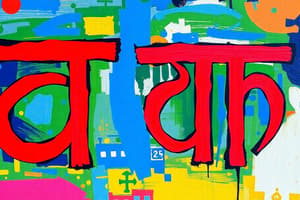Podcast
Questions and Answers
What is the primary script used to write Hindi?
What is the primary script used to write Hindi?
- Latin script
- Arabic script
- Devanagari script (correct)
- Cyrillic script
Which of the following best describes the grammatical structure of Hindi?
Which of the following best describes the grammatical structure of Hindi?
- Uses a Subject-Verb-Object (SVO) order
- Follows a Subject-Object-Verb (SOV) order (correct)
- Uses a Verb-Object-Subject (VOS) order
- Follows a Verb-Subject-Object (VSO) order
What is a significant challenge faced by Hindi in urban areas?
What is a significant challenge faced by Hindi in urban areas?
- Inability to adapt to modern technology
- Limited use in film and music
- Influence of regional languages and English (correct)
- Lack of literature in Hindi
Which of the following dialects is NOT associated with Hindi?
Which of the following dialects is NOT associated with Hindi?
Which of the following is true about Hindi vocabulary?
Which of the following is true about Hindi vocabulary?
Flashcards are hidden until you start studying
Study Notes
Overview of Hindi
- Hindi is an Indo-Aryan language primarily spoken in India.
- It is the official language of the Indian government and one of the 22 scheduled languages in India.
Language Family
- Part of the Indo-European language family.
- Derived from Sanskrit, and belongs to the Central Zone of the Indo-Aryan languages.
Script
- Written in the Devanagari script, which consists of 48 characters (14 vowels and 34 consonants).
- Devanagari is written from left to right.
Phonetics
- Contains a rich array of sounds including unique retroflex consonants.
- Vowels can be short and long, altering meaning in words.
Grammar
- Generally follows Subject-Object-Verb (SOV) word order.
- Nouns have gender (masculine or feminine) and number (singular or plural).
- Adjectives agree in gender and number with the nouns they modify.
Vocabulary
- A mix of native words (Sanskrit and Prakrit origins) and loanwords from Persian, Arabic, English, and Portuguese.
- Common themes in vocabulary: family, professional terms, daily activities, and abstract concepts.
Dialects
- Numerous regional dialects, including:
- Bhojpuri
- Awadhi
- Maithili
- Braj Bhasha
- Each dialect has its own variations in pronunciation and vocabulary.
Cultural Significance
- Hindi is a medium for a vast array of literature, film (Bollywood), music, and theater in India.
- Acts as a unifying language in a linguistically diverse country.
Challenges
- Variability in pronunciation and spelling across different regions.
- Hindi faces competition from regional languages and English, particularly in urban areas.
Learning Resources
- Various language courses available online and in educational institutions.
- Rich array of media – films, songs, and literature for immersive learning.
Global Presence
- Spoken by over 500 million people worldwide.
- Significant communities in countries like Nepal, Fiji, Mauritius, and among the Indian diaspora globally.
Overview of Hindi
- Hindi is an Indo-Aryan language spoken primarily in India, serving as the official language of the Indian government.
- It is one of the 22 scheduled languages in India.
Language Family
- Hindi belongs to the Indo-European language family, derived from Sanskrit.
- It is categorized within the Central Zone of the Indo-Aryan languages.
Script
- Hindi is written in the Devanagari script, which comprises 48 characters - 14 vowels and 34 consonants.
- Devanagari is written from left to right.
Phonetics
- Hindi contains a rich array of sounds, including unique retroflex consonants.
- Vowel length is significant, differentiating meaning in words.
Grammar
- Hindi generally follows the Subject-Object-Verb (SOV) word order.
- Nouns possess gender (masculine or feminine) and number (singular or plural).
- Adjectives agree in gender and number with the nouns they modify.
Vocabulary
- Hindi vocabulary is a blend of native words (Sanskrit and Prakrit origins) and loanwords from Persian, Arabic, English, and Portuguese.
- Common themes include family, professional terms, daily activities, and abstract concepts.
Dialects
- Numerous regional dialects exist, including Bhojpuri, Awadhi, Maithili, and Braj Bhasha.
- Each dialect exhibits variations in pronunciation and vocabulary.
Cultural Significance
- Hindi serves as a medium for a vast array of literature, film (Bollywood), music, and theater in India.
- It acts as a unifying language in a linguistically diverse country.
Challenges
- Pronunciation and spelling can vary significantly across different regions.
- Hindi faces competition from regional languages and English, particularly in urban areas.
Learning Resources
- Language courses are readily available online and in educational institutions.
- A rich array of media – films, songs, and literature – offer immersive learning opportunities.
Global Presence
- Hindi is spoken by over 500 million people worldwide.
- Significant communities exist in countries like Nepal, Fiji, Mauritius, and among the Indian diaspora globally.
Studying That Suits You
Use AI to generate personalized quizzes and flashcards to suit your learning preferences.




